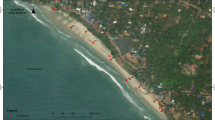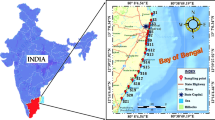Abstract
Port Said is an Egyptian coastal city, laying on Mediterranean Sea. The city is a world-renowned international harbor and a free-trade zone. Therefore, it is one of the most popular shopping destinations in Egypt, where people can buy duty-free goods and enjoy the city’s free public beaches in summer vacations. Recent radiological hazards studies had located several high radioactive lenses along the Nile Delta coastline, resulted from accumulations of black sand deposits. Concerns had been raised regarding the safety of individuals who might be exposed to high doses of radiations due to the presence of black sand deposits along Port Said beach, especially when the beach is characterized by positive accretion rates. Detailed ground radioactivity surveys were conducted at the beach aiming to measure the activity concentrations of the naturally occurring radioelements (238U, 232Th and 40K). Spatial distributions of the three elements were mapped. Dose Rate (DR) and Annual Effective Dose Rates (AEDR) were calculated. Although the results of AEDR revealed that the radiations levels are fallen within the allowed limits, the Excess Lifetime Cancer Risk (ELCR) factor exceeded the world’s average of 0.25. For public awareness, high-risk areas were delineated on a risk map, showing the locations where gamma radiation emissions exceeded the allowed exposure limits for humans. It is recommended to apply the same surveying procedures at all of the public beaches along Sinai coasts, where larger quantities of Black Sands had been detected along its shoreline.






Similar content being viewed by others
References
Abdel-Razek, Y., Abu-Diab, A., & Bakhit, A. (2013). Correlation between the concentrations of the heavy minerals and the terrestrial radioactivity at El Massaid and El Kharrouba, Sinai, Egypt. In Paper presented at the Proceedings of the XI Radiation Physics and Protection Conference, pp. 25–28.
Attia, T., Shendi, E., & Shehata, M. (2015). Assessment of natural and artificial radioactivity levels and radiation hazards and their relation to heavy metals in the industrial area of Port Said city, Egypt. Environmental Science and Pollution Research,22(4), 3082–3097.
Avwiri, G., Egieya, J., & Ononugbo, C. (2013). Radiometric assay of hazard indices and excess lifetime cancer risk due to natural radioactivity in soil profile in Ogba/Egbema/Ndoni local government area of rivers state, Nigeria. Academic Research International,4(5), 54–65.
Aziz, A., Attia, T., McNamara, L., & Friedman, R. (2019). Application of gamma-ray spectrometry in discovering the granitic monument of King Pepi I: a case study from Hierakonpolis, Aswan, Egypt. Pure and Applied Geophysics,176(4), 1639–1647.
Dawood, Y., & El-Naby, H. A. (2007). Mineral chemistry of monazite from the black sand deposits, northern Sinai, Egypt: a provenance perspective. Mineralogical Magazine,71(4), 389–406.
El-Gamal, A. A., & Saleh, I. H. (2012). Radiological and mineralogical investigation of accretion and erosion coastal sediments in Nile Delta region, Egypt. Journal of Oceanography and Marine Science,3(3), 41–55.
El-Hinnawi, E. E. (1964). Mineralogical and geochemical studies on Egyptian (UAR) black sands. Beiträge zur Mineralogie und Petrographie,9(6), 519–532.
Embabi, N. S. (2018). The Nile Delta. Landscapes and landforms of Egypt (pp. 57–68). Berlin: Springer.
Geosoft Oasis Montaj. (2013). Software for earth science mapping and processing. Geosoft Incorporation Ltd.
Hazin, C. A., de Farias, E. E., & Gazineu, M. H. P. (2008). Uranium and thorium in zircon sands processed in Northeastern Brazil. In IRPA 12: 12 International congress of the International Radiation Protection Association (IRPA): Strengthening radiation protection worldwide. Argentina: SAR
Hegazy, A., & Emam, M. (2010). Accumulation and soil-to-plant transfer of radionuclides in the Nile Delta coastal black sand habitats. International Journal of Phytoremediation,13(2), 140–155.
IAEA. (1989). International Atomic Energy Agency, Measurement of Radiation in Food and the Environment. Guidebook. Technical Report Series, No. 295. Vienna: IAEA.
IAEA. (2003). International Atomic Energy Agency, Guidelines for radioelement mapping using gamma ray spectrometry data. Technical Documents, No. 1363. Vienna: IAEA.
Kaiser, M., Aziz, A., & Ghieth, B. (2014). Environmental hazards and distribution of radioactive black sand along the Rosetta coastal zone in Egypt using airborne spectrometric and remote sensing data. Journal of Environmental Radioactivity,137, 71–78.
Mowafi, W., & El Tahawy, M. (2009). Radiological investigation of the black sand region of the North-East of the Nile Delta. In Paper presented at the Proceedings of the 7th Conference on Nuclear and Particle Physics, Sharm El-Sheikh. Sinai, Egypt, pp. 11–15.
Said, R. (2017). The geology of Egypt. Abingdon: Routledge.
Saito, K., & Jacob, P. (1995). Gamma ray fields in the air due to sources in the ground. Radiation Protection Dosimetry,58(1), 29–45.
Samra, R. M. A. (2017). The use of cartographic modeling to assess the impacts of coastal flooding: a case study of Port Said governorate, Egypt. Environmental Monitoring and Assessment,189(9), 435.
Taskin, H., Karavus, M., Ay, P., Topuzoglu, A., Hidiroglu, S., & Karahan, G. (2009). Radionuclide concentrations in soil and lifetime cancer risk due to gamma radioactivity in Kirklareli, Turkey. Journal of Environmental Radioactivity,100(1), 49–53.
UNSCEAR. (2000). Sources and effects of ionizing radiation, volume I: sources, annex B. Exposures from natural radiation sources: United Nations. In Scientific Committee on the Effects of Atomic Radiation, report to the general assembly on the effects of atomic radiation to the general assembly.
Woodward, J. C., Macklin, M. G., Krom, M. D., Williams, M. A., & Gupta, A. (2007). The Nile: evolution, Quaternary river environments and material fluxes. Large Rivers,13, 712.
Acknowledgements
The authors wish to thank the PSU Center of Environmental Studies and Consultancies, for providing the necessary equipment and permissions to conduct the field surveys. We are very grateful to Dr. Mohamed Shehata and Mr. Kareem Afifi for his valuable help and effort during the field surveys.
Author information
Authors and Affiliations
Corresponding author
Additional information
Publisher's Note
Springer Nature remains neutral with regard to jurisdictional claims in published maps and institutional affiliations.
Rights and permissions
About this article
Cite this article
Aziz, A., Attia, T. & Hanafi, M. Radiological Impact and Environmental Monitoring of Gamma Radiations Along the Public Beach of Port Said, Egypt. Pure Appl. Geophys. 177, 2871–2876 (2020). https://doi.org/10.1007/s00024-019-02398-8
Received:
Revised:
Accepted:
Published:
Issue Date:
DOI: https://doi.org/10.1007/s00024-019-02398-8




